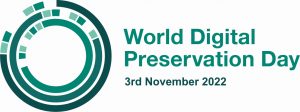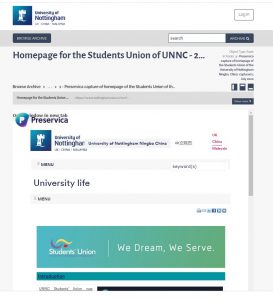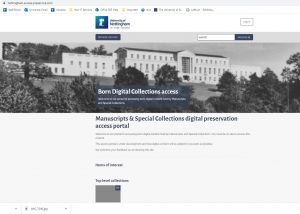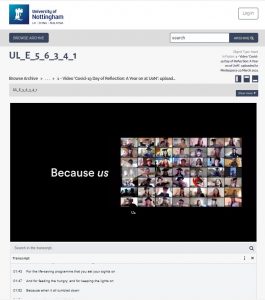November 3, 2022, by Kathryn Steenson
Discovering the digital: Developing born digital access
This is a post by Laura Peaurt, Digital Preservation Officer.
 Today we celebrate World Digital Preservation Day. The theme for this year’s event is ‘Data for All, For Good, Forever’, and this event is a chance for us to reflect on our work within Manuscripts and Special Collections to collect, preserve and make accessible our digital collections.
Today we celebrate World Digital Preservation Day. The theme for this year’s event is ‘Data for All, For Good, Forever’, and this event is a chance for us to reflect on our work within Manuscripts and Special Collections to collect, preserve and make accessible our digital collections.
We have spent the last three years focussed on the ‘forever’ part of this statement as we completed a programme to move our digital collections into a digital preservation management system which allows us to safeguard, monitor and actively preserve our digital collections long into the future.
This system has also given us the tools to actively collect new digital content produced by the university community and which reflects its activities and impact. This content includes websites, social media feeds, digital publications, and digital records from within the institution.
Now that our collections are safeguarded with secure digital storage, we turn our attention to increasing the opportunities for our community to access and use these collections.
We already have several avenues available to access our digital collections, most notably the Digital Gallery which highlights some of our digitised images and provides a fantastic introduction to our collections.
Our physical and digital collections can also be accessed from our public reading room on Kings Meadow Campus, and we are currently focused on improving and expanding our ability to provide access to born digital collections from this space.
For our born digital collections (such as institutional records, websites and digital audiovisual collections) we must consider access restrictions which may be in place regarding intellectual property rights and/or material which contains sensitive content. Some of our digital files may be in unusual file formats that are not supported by many content discovery systems.

Preservica playing an archived video from the Students Union on Ningbo Campus of The University of Nottingham. Ref: UU/UNNC/P/3

Images showing screenshots taken from the Covid-19 Reflection One Year on video produced by The University of Nottingham. Ref: UL/E/5/6/3/4/1

Homepage of Student Union Ningbo Campus, China. Captured and archived by Preservica and displayed via the Universal Access tool. Ref: UU/1/UNNC/W/1
Our digital preservation solution includes a public access tool known as Universal Access. This includes built-in viewers that allow us to deliver a wide variety of file types to our researchers from one system. Examples include office documents (e.g., Microsoft Word, Excel, PDF), archived websites and social media feeds, videos, sound and image files. We hope to launch this new tool soon to provide easier access to our born digital collections.

Homepage of our beta access tool which will be available in our reading room at Kings Meadow Campus.

Testing the digital access pc setup in our reading room. Screen shows an archived capture of the homepage of the Students Union of The University of Nottingham Ningbo, China, captured 1 July 2020. Ref: UU/UNNC/W/2
We have just begun an assessment of our born digital access provision using the NDSA Levels of Born Digital Access framework. This has already proved extremely useful in benchmarking where we are and identifying how we might make progress and ensure we consider accessibility needs throughout.
We continue to test access using this tool and hope to launch it soon. Further information about accessing our collections (digital or non-digital) in our reading room can be found on our website: https://www.nottingham.ac.uk/mss/readingroom/introduction.aspx
No comments yet, fill out a comment to be the first



Leave a Reply